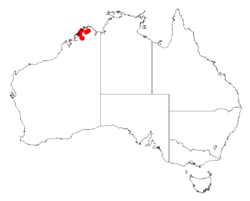Biology:Acacia diastemata
| Sandstone pavement wattle | |
|---|---|
| Scientific classification | |
| Kingdom: | Plantae |
| Clade: | Tracheophytes |
| Clade: | Angiosperms |
| Clade: | Eudicots |
| Clade: | Rosids |
| Order: | Fabales |
| Family: | Fabaceae |
| Subfamily: | Caesalpinioideae |
| Clade: | Mimosoid clade |
| Genus: | Acacia |
| Species: | A. diastemata
|
| Binomial name | |
| Acacia diastemata Maslin, M.D.Barrett & R.L.Barrett
| |

| |
| Occurrence data from AVH | |
Acacia diastemata, also known as the sandstone pavement wattle,[1] is a shrub to small tree belonging to the genus Acacia and the subgenus Juliflorae that is endemic to a small area of north-western Australia .
Description
The shrub or small tree typically grows to a height of 2 to 5 m (6 ft 7 in to 16 ft 5 in) and has a loose and erect habit. It has grey coloured bark with a fibrous texture and glabrous finely ribbed that are brown but become grey with age. Like most species of Acacia it has phyllodes rather than true leaves. The thin and pliable evergreen phyllodes have a narrowly linear shape with a length of 9 to 16 cm (3.5 to 6.3 in) and a width of 1 to 2 mm (0.039 to 0.079 in) and terminate in a blunt point. The glabrous phyllodes are straight to shallowly incurved and have three widely spaces longitudinal nerves.[1] It flowers between March and June producing yellow flowers.[2]
Distribution
It is native to an area in the east Kimberley region of Western Australia[2] where it has widespread but quite localised populations from around the Prince Regent River in the south west to around the Roe River in the north and to the Drysdale River National Park in the east.[1] The wattle is spread over a range of approximately 200 km (120 mi) and is usually situated on among rocks on ridges composed of quartzite or sandstone or of more massive sandstone pavements in small stands where it is often part of scrubland communities including Acacia kenneallyi, Hibiscus superbus, Macarthuria vertex and species of Triodia and Triumfetta.[1]
See also
References
- ↑ 1.0 1.1 1.2 1.3 "Acacia diastemata Maslin, M.D.Barrett & R.L.Barrett". Wattle - Acacias of Australia. Lucid Central. https://apps.lucidcentral.org/wattle/text/entities/acacia_diastemata.htm. Retrieved 3 April 2020.
- ↑ 2.0 2.1 "Acacia diastemata". FloraBase. Western Australian Government Department of Parks and Wildlife. https://florabase.dpaw.wa.gov.au/browse/profile/43561.
Wikidata ☰ Q24190085 entry
 |


